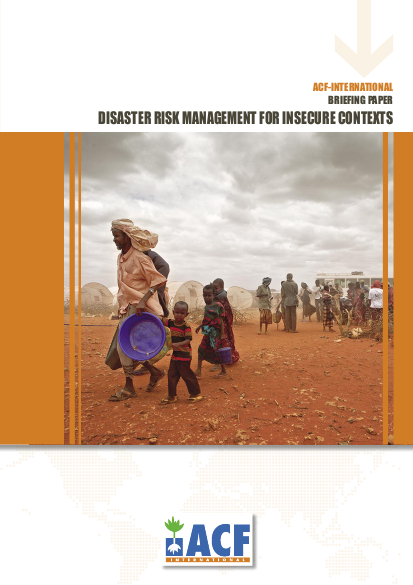
In insecure contexts there is often a self-reinforcing spiral: conflict creates more vulnerability to disaster and more vulnerability to disaster creates further conflict. This is compounded by climate change, environmental degradation, market fragility, economic marginalisation, migration and unplanned urbanisation. Aid is currently too disjointed to address this spiral effectively. Each agency has disparate policies, teams and operations for disaster risk management (DRM) and for insecurity programming (IP). However, the common objectives and the combined impact of the various approaches to DRM, IP and relief and recovery operations can be harnessed to develop a long-term strategy promoting peace and resilience to all forms of threats and hazards. Such integration would lead to more streamlined operations and a more efficient use of funds.
There needs to be greater investment in DRM, especially during periods of transition to more stability, ensuring that DRM encompasses both threats related to insecurity and to hazards related to external events such as natural hazards and market shocks. DRM programming can be adapted to many insecure contexts by using a graduated management system based on multi-hazard threats surveillance and an early warning system. The following principles are suggested as the basis for adjusting DRM practice:
- An ‘open vision’ of risk that encompasses all hazards and threats.
- Insecurity factors considered as key in identifying, assessing and designing DRM programming, rather than as a filter applied after the programme has been defined.
- Changing traditional DRM partnerships and operational modalities: Where regimes undermine the autonomy and safety of people or where governments are one of the conflict parties, then alternative operational arrangements need to be investigated.
- A household-level instead of a community-level focus: Where different groups within communities are pitted against each other, the household becomes the basic unit of programming until entry points can be found to help repair inter-group relations.
- A flexible approach to working with communities: There should be no prescribed community approach for DRM action. The context and the capacities and wishes of the community will dictate the approach used.
- A modified sustainability focus to include both short- and long-term aims: This means (a) aiming for shorter-term impacts while building in actions that prepare for longer-term peace-building objectives and (b) emphasising portable technology for displaced populations.
- Accommodating uncertainty (such as unplanned events and fluctuating access to vulnerable people) through flexible programming. This requires inter-agency coordination to establish and maintain an integrated surveillance and early warning system that merges analyses of natural hazards, hunger and political/conflict issues.
- Considering the political dimension of programming: when applied to insecure contexts, DRM needs to address the challenges of diminishing neutral humanitarian space.
- Using natural hazards as a ‘neutral’ entry point to conflict reduction: To maximise this potential, external actors need a long-term commitment beyond humanitarian and media-friendly action.
- Integrated advocacy to address long-term issues linked to disaster drivers.
Links
Resource collections
- UN Habitat - Urban Response Collection
- Urban Response - Urban Crisis Preparedness and Risk Reduction
- Urban Response Collection - Community Engagement and Social Cohesion
- Urban Response Collection - Economic Recovery
- Urban Response Collection - Environment and Climate Change
- Urban Response Collection - Housing, Land and Property
- Urban Response Collection - Urban Crisis Response, Recovery and Reconstruction
- Urban Response Collection - Urban Resilience